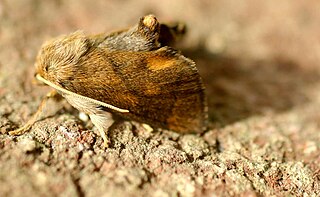
Caterpillars are the larval stage of members of the order Lepidoptera.

Lepidoptera is an order of insects that includes butterflies and moths. About 180,000 species of the Lepidoptera are described, in 126 families and 46 superfamilies, 10 per cent of the total described species of living organisms. It is one of the most widespread and widely recognizable insect orders in the world. The Lepidoptera show many variations of the basic body structure that have evolved to gain advantages in lifestyle and distribution. Recent estimates suggest the order may have more species than earlier thought, and is among the four most speciose orders, along with the Hymenoptera, Diptera, and Coleoptera.

The Pyralidae, commonly called pyralid moths, snout moths or grass moths, are a family of Lepidoptera in the ditrysian superfamily Pyraloidea. In many classifications, the grass moths (Crambidae) are included in the Pyralidae as a subfamily, making the combined group one of the largest families in the Lepidoptera. The latest review by Eugene G. Munroe and Maria Alma Solis, in Kristensen (1999) retains the Crambidae as a full family of Pyraloidea.

The Pyraloidea are a moth superfamily containing about 16,000 described species worldwide, and probably at least as many more remain to be described. They are generally fairly small moths, and as such, they have been traditionally associated with the paraphyletic Microlepidoptera.

The Limacodidae or Eucleidae are a family of moths in the superfamily Zygaenoidea or the Cossoidea; the placement is in dispute. They are often called slug moths because their caterpillars bear a distinct resemblance to slugs. They are also called cup moths because of the shape of their cocoons.
Agathiphaga is a genus of moths in the family Agathiphagidae, known as kauri moths. This caddisfly-like lineage of primitive moths was first reported by Lionel Jack Dumbleton in 1952, as a new genus of Micropterigidae.

Coptodisca is genus of moths of the family Heliozelidae. It was described by Walsingham in 1895.
Coptodisca arbutiella, the madrone shield bearer, is a moth of the family Heliozelidae. It was described by August Busck in 1904. It is found in western North America from California to British Columbia.
Coptodisca condaliae is a moth of the family Heliozelidae. It was described by August Busck in 1900. It is found in Florida.
Coptodisca diospyriella is a moth of the family Heliozelidae. It was described by Vactor Tousey Chambers in 1874. It is found in North America, including Florida, Kentucky and Ohio.
Coptodisca ella is a moth of the family Heliozelidae. It was described by Vactor Tousey Chambers in 1871. It is found in North America, including Tennessee.
Coptodisca kalmiella is a moth of the family Heliozelidae. It was described by Dietz in 1921. It is found in North America, including New Jersey.

Coptodisca lucifluella is a moth of the family Heliozelidae. It was described by James Brackenridge Clemens in 1860. It is found in North America, including Kentucky and Ohio.
Coptodisca magnella is a moth of the family Heliozelidae. It was described by Annette Frances Braun in 1916. It is found in North America, including Kentucky, Mississippi and Ohio.
Coptodisca negligens is a moth of the Lepidopteria family. It was described by Annette Frances Braun in 1920. It is found in North America, including Ohio.
Coptodisca ostryaefoliella is a moth of the family Heliozelidae. It was described by James Brackenridge Clemens in 1861. It is found in North America, including Ohio.
Coptodisca powellella is a moth of the family Heliozelidae. It was described by Opler in 1971. It is found in California.
Coptodisca quercicolella is a moth of the family Heliozelidae. It was described by Annette Frances Braun in 1927. It is found in North America including California and Colorado.
Coptodisca rhizophorae is a moth of the family Heliozelidae. It was described by Walsingham in 1897. It is found in the West Indies.
Coptodisca ribesella is a moth of the family Heliozelidae. It was described by Annette Frances Braun in 1925. It is found in the US state of California.





